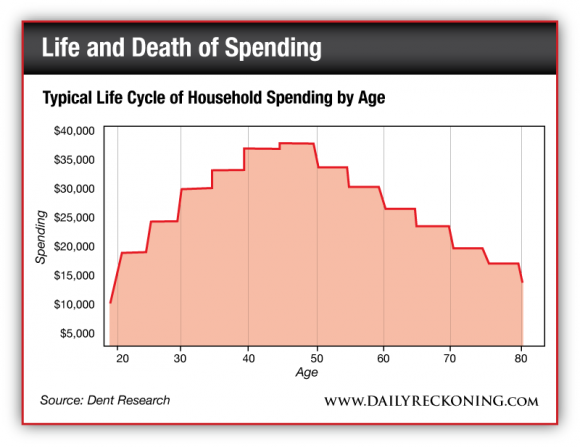A Reasonable Way to Predict the Future
The Federal Reserve Bank gets a lot of press. But Harry Dent has another idea about what investors should pay attention to.
“What is more important than all the central banks of the world?” he asked the attendees at the Liberty Forum in sunny St. Kitts. The crowd, perhaps under the tranquilizing effect of the tropics, offered no guesses.
“Babies,” Harry said.
There are many ways people make their guesses about what might happen in the world. Some people gaze at the stars. Some follow oddball theories of dead economists. Harry Dent — author, newsletter writer, forecaster of market trends — watches babies.
“What I do is look at demographics,” Harry said, adding specifics, “and the predictable things people do as they age.”
And that all starts with babies. On the next slide, Harry produced a picture of a cute little bundle in a blue blanket. “What’s going to happen to this baby? He’s going to grow up. He’s going to enter the workforce at age 20. He’s going to start earning money, spending money, borrowing money,” Harry said. “Does anyone know at what age you spend the most you’ll spend in your life?”
That would be age 46. Here was something that I thought was interesting. Harry mapped out the typical life cycle of household spending in the chart below.
Childbirth comes at age 28. Maximum spending on groceries tends to hit at age 41, when that kid becomes a teen. “It’s a proven medical fact,” Harry said, “that the highest calorie intake happens during those teenage years.” (I can vouch for this. It seems all my wife and I do is go grocery shopping.)
Spending on furniture peaks at age 46. College tuition spending at age 51. And the most you’ll ever spend on a car is when you turn 53 (you finally get that Cadillac!). “This is usually the last major durable good purchase people make. After this, spending goes down much faster,” Harry said. “And so does borrowing. Old people don’t borrow money. They pay down debt.”
Life insurance spending peaks at 58, travel expenses at 60 and cruise ship spending at age 70. “People finally say, ‘Put me on a cruise ship, stuff me with food and booze and I’m happy. No jet lag. No hassles,’” Harry says.
“All of these things happen from cradle to grave, predictably,” Harry summed up. I’ve always had an armchair interest in these sorts of stats. Of all the things you could use to try to predict the future, the demographic trends seem to make sense. And they are hard to change.
From this kind of analysis, Harry teases out what might do well and what might not. Short auto stocks and buy RVs is one example Harry offered. Why? We’re past the peak on auto spending. But for RVs, the maximum spending happens between ages 53-60. We’re entering the sweet spot.
“I’d be building nursing homes and assisted living facilities for decades,” Harry added. “That’s where I’d be investing.”
Regards,
Chris Mayer,
for The Daily Reckoning
P.S. Harry’s insights at the Liberty Forum in St. Kitts gave me a different perspective on some of the ways I approach investing. After all, to be a successful investor, it’s vitally important to keep an open mind, stay nimble and never be afraid to change your opinion. Today, I asked readers of The Daily Reckoning email edition to do just that… I gave them the chance to get a first-hand look at one “hands-off” investment strategy that could have turned every $1 they invested into $50. This opportunity won’t be around forever (in fact, by the time you read this, it may very well be gone). But that’s just one more reason to sign up for the FREE Daily Reckoning email edition… Every single day, readers are treated to a variety of incredible “first-strike” investment opportunities just like this. And you could start receiving them for yourself for FREE, right now. So don’t wait. Sign up for the FREE Daily Reckoning email edition, right here, and never miss another opportunity to discover life-changing profits.




Comments: